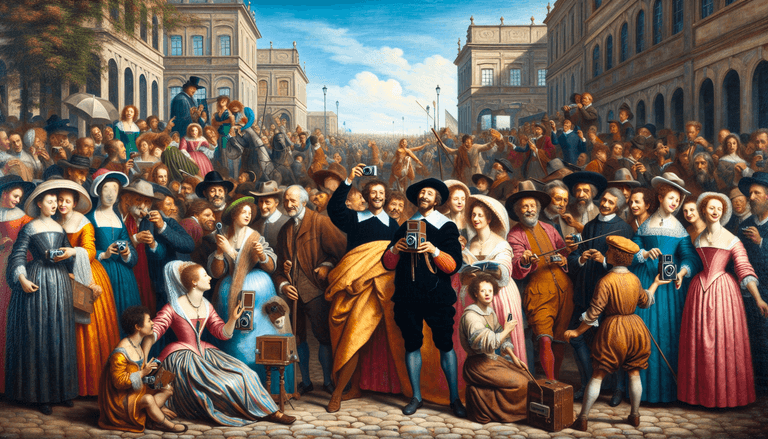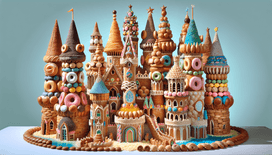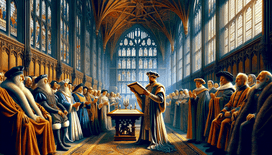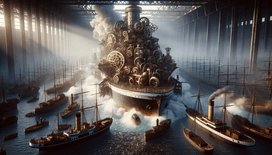Ah, the Renaissance, a period of rebirth for art, culture, and Instagram models! Wait... not quite. But imagine, if you will, how this grand epoch might have flowered differently if it had been fertilised with the ever-popular social media app, Instagram.
The Power of Selfies in Self-Portraits
Our first contender in this alternate timeline is none other than Leonardo da Vinci, perhaps spending less time mixing egg yolks with pigments and more time perfecting that duck-face angle. Da Vinci's masterpieces, from the enigmatic Mona Lisa, perhaps better known online as @SmirkyLisa, to his anatomically detailed sketches, would most certainly 'break the gram'. Imagine the followers, shares, and the obligatory "this is fire" comments from admirers fascinated by his use of chiaroscuro.
One can almost envision his account bio: "Renaissance Man | Inventor | Painter | Probable Time Traveller." And of course, he would have thrown a filter or two on the masterpieces just to catch the right light reminiscent of a Tuscan sunset.
The Caption Renaissance
If Shakespeare taught us anything, it's that words woo hearts. Renaissance artists on Instagram would no doubt revel in crafting tantalising captions like "Simplicity is the ultimate sophistication #ArtGoals" or "When in Florence... paint!" Perhaps shifting from the quill to typing with nimble fingers, these artists would tiptoe the fine line between fragility and flourish in 280 characters or less.
Mona Lisa’s Mysterious Emoji
As for Mona herself, she might have quite the online personality, known for posting enticing photos of her swoon-worthy landscape with captions like, "Living my best enigmatic life! 🌿🖌️ #NoFilter". And what of her elusive smile? For that, we’d have the likes of art critics filling the comments section with "Is it a smirk? A smile? An accidental candid?", #InterpretationInvites!
Stories of the Sistine Chapel, Now in 15 Seconds
Enter Michelangelo, the original multi-tasker (seriously, just think of his biceps). His documentation of the Sistine Chapel's progress could easily rival today’s time-lapse videos. Imagine a peek behind the scenes with a quick swipe through his stories, detailing "The Creation of Adam: Highlights & Tutorials" and "Fresco Fever - Late Night Caffeinated Musings." You can almost hear him say "Swipe up for a full tutorial on frescos!"
The Florence Filter and Art Influencers
Of course, being a Renaissance influencer comes with its pros and cons. There'd undoubtedly be the purists, remarking that painting a ceiling with a brush is a way of life, not an Instagram challenge, whilst young, budding artists would hashtag #FlorenceFilter to cleverly mimic the time's rich colours and shadows.
More importantly, merchants like the Medici would surely capitalise on these influencer platforms. Instead of financing artists with florins, they'd offer promo codes, pushing the latest workshop crafts, buy one bronze statuette, get one quill pen free!
Collaborations and Hashtags of History
Where might we see collaboration in this hashtag-toting universe? Perhaps Titian and Botticelli team up for a #BirthofVenusChallenge, seeing who can re-interpret the birth goddess in more creative ways, complete with behind-the-scenes content and collaborative workshops livestreamed to their devoted followers.
The Legacy Left Behind
Ultimately, the Renaissance’s Instagram-ed version not only reshapes our vision of art but places these creators not atop pedestals but alongside today's digital connoisseurs. It's a tapestry interwoven with connectivity, where every "like" and "comment" becomes a brushstroke of motivation, spurring them onto greatness. If there’s one takeaway here, it’s that social media, like any societal canvas, has its trailblazers and trendsetters.
So, let us muse upon this notion: what's a little virtual validation compared to the admiration of the ages? Is art truly timeless if it can’t snag a feature on the Explore page? Maybe. Or maybe it's in finding that fine filter, that piece of forever captured in a single, fleeting moment. After all, isn't every age due its Renaissance?







